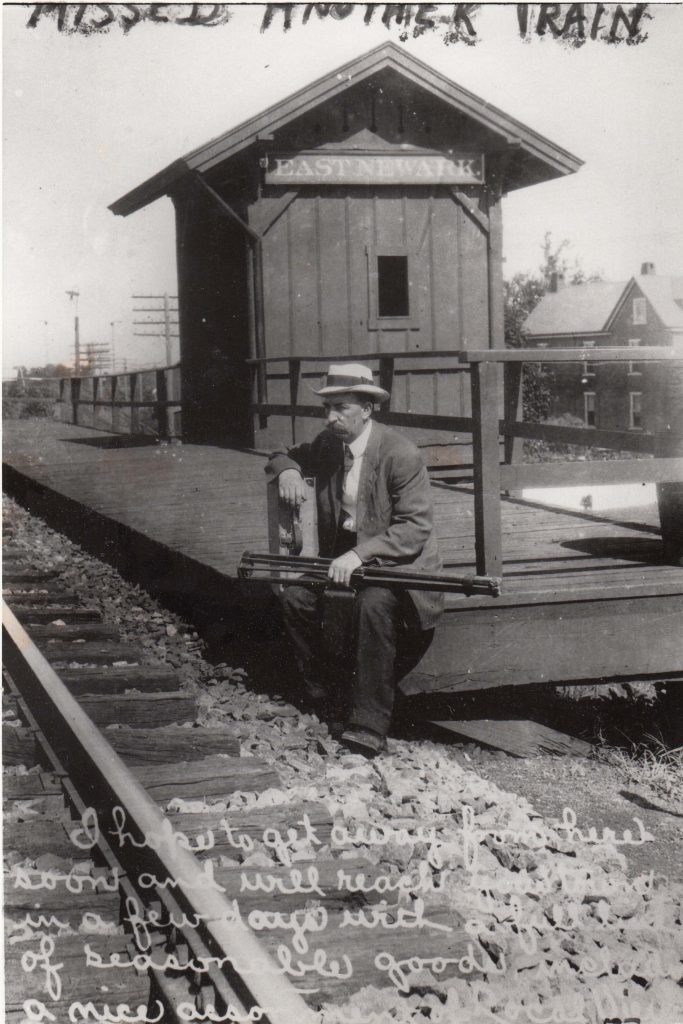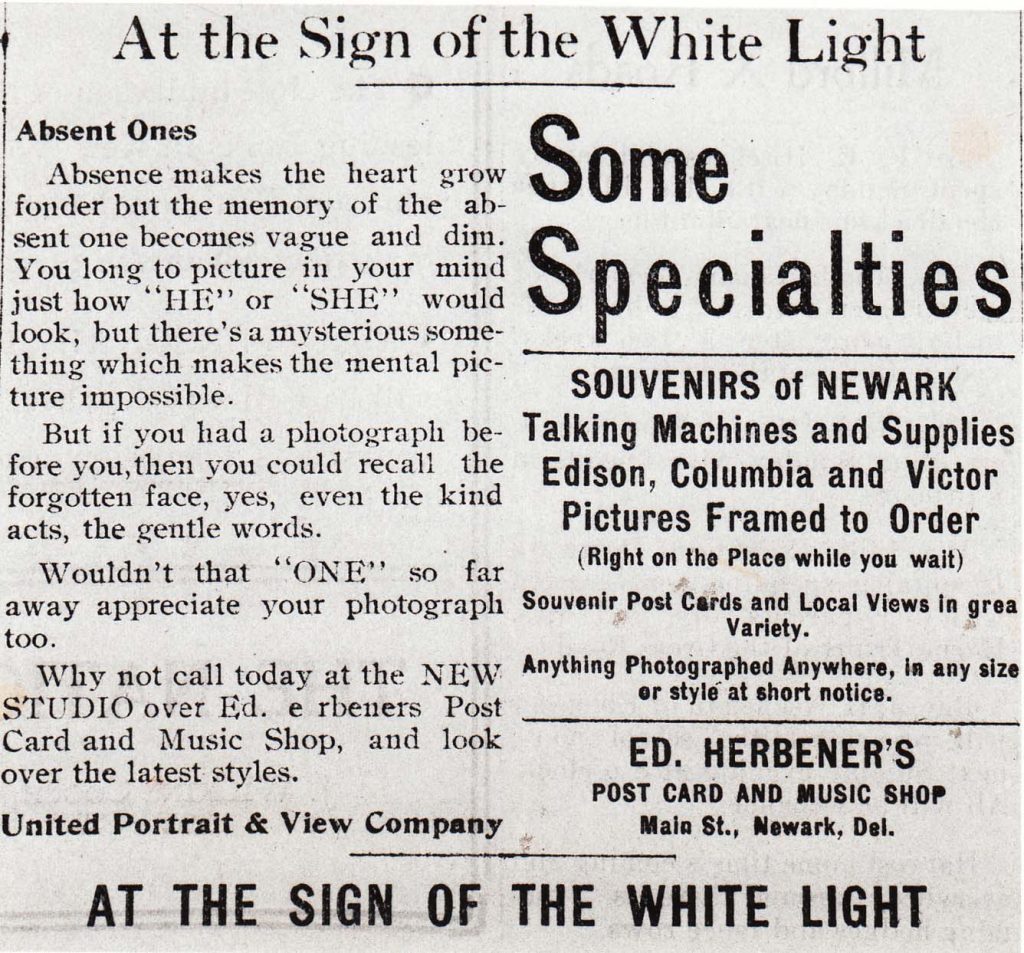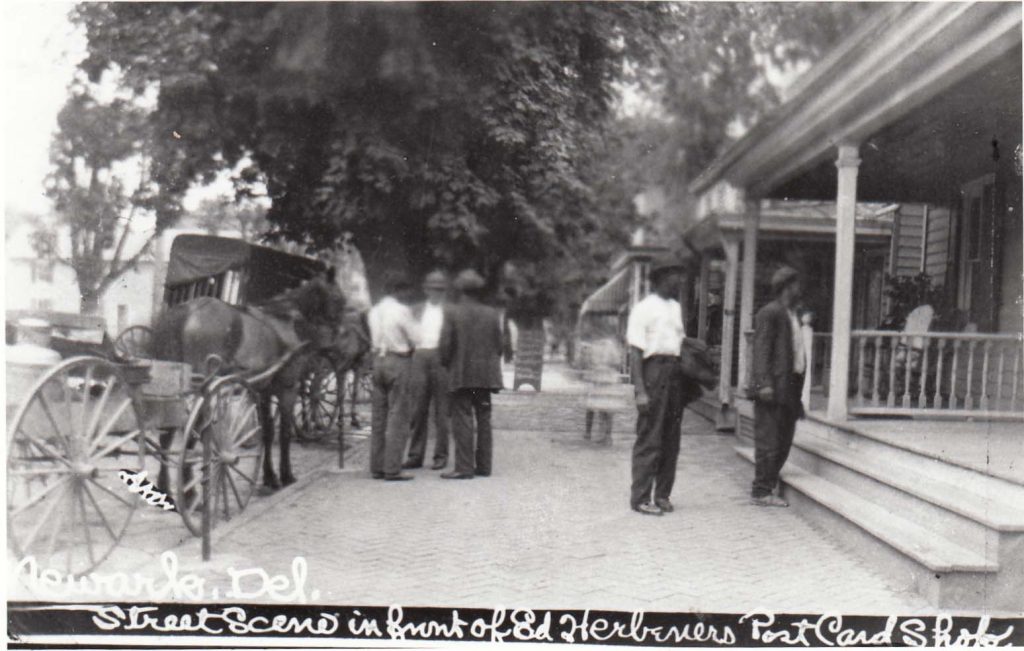George Miller
Edward Herbener
Postcard Photographer

Postcard self-portrait of Edward Herbener. The writing on the photograph was an advertisement which reads: “I hope to get away from here soon and will reach your town in a few days with a full line of seasonable goods, including a nice assortment of local views.”

At a slide lecture in our local library some years ago on the photographs of Edward Herbener, I was holding forth on how much the residents of Newark, Delaware, owed this unsung hero. In the front row sat an older man and woman, and when I finally paused to catch my breath, the man said, “He was our father.”
After the lecture I approached Harry Herbener and his sister Leila and asked whether any of their father’s photographs or negatives survived. “No,” they replied, everything had been stored in a basement and ruined by water damage.
After several years of procrastination, I reconnected with them. Harry was now 88 but he was able to tell me what he remembered about his father and his business. From that information I was able to construct a brief sketch of Herbener’s early days in Newark.
* * *
John Edward Herbener was born in Philadelphia on May 9, 1867, the son of John H. Herbener and Mary Elizabeth Zenz. The family moved to Strickersville, Pennsylvania, about four miles north of Newark, Delaware, where Edward grew up. His father John operated a tailor’s shop in Newark until 1910—when he was 80 years of age. As a young man, Edward was fascinated by magic and photography. With his trunk full of magic tricks, he was a frequent entertainer in local schools where he also demonstrated his skill as a hypnotist, his first camera was home-made, built in 1887.
Information also came from other sources. I could place his business from the backs of two local photographs which carried Herbener advertising imprints. One from Strickersville noted: “Landscape, Buildings, Animals, etc., Photo’d anywhere at Short Notice. Small photos tintypes, & c., copied and enlarged to any size or style at reasonable rates.” As second similar imprint placed him in Appleton. Maryland, just outside of Newark. His first location in town was at his father’s tailor shop.
According to the family, during the period from about 1889 to 1892, Herbener was employed by the United View Company as a traveling photographer. It was during one of his trips that he met Mary Alice Humphrey of Belmont, Ohio. Married in 1892, they traveled by horse and buggy to the World’s Columbian Exposition in Chicago for their honeymoon. The Herbeners returned to Newark and in 1894, a daughter Leila was born and in 1895, a son Harry.
In the early 1900s, Newark, Delaware, had a population of about 2,500. In many small towns, very few records survive. There were no city directories, no telephone books, and not even a local newspaper until 1910. Searching for other pieces of information, I eventually found two business listings. In the Delaware State and Peninsula Directory, 1899-1900 (Wilmington, 1889), Herbener is listed as a dealer in “art goods.” In the R. L. Polk & Company Peninsula Directory of Delaware, Eastern Shore of Maryland and Virginia … 1908-09 (Baltimore, 1908) he appears as “United View Company.”
Judging from the cards which survive, what is certain is that Herbener was photographing Newark and the surrounding area during the period from 1900 until 1915 and reproducing those photographs on postcards. He was linked in some way to George A. Wolf, a Wilmington printer and publisher of postcards. According to the Wilmington city directories, Wolf was in business from 1905 until 1910. Some of Wolf’s cards—all of which are commercially printed issues which carry his imprint on the view side—reproduce Herbener’s photographs. Furthermore, some of the Wolf issues carry a rubber-stamped imprint for Herbener and/or the United View Company. Undoubtedly Herbener sold Wolf cards, but I suspect that when Wolf went out of business in 1910, he sold his stock of view cards to Herbener.
In the hope of finding more on Herbener and his business, I turned to the microfilmed copies of the Newark Post, the weekly newspaper that began publication in January 1910. First, the issues were skimmed and regular advertisements for Herbener’s store were found. But more was needed, so a full-read of five years-worth of newspapers was undertaken.
The first mention of Edward Herbener came on February 9, 1910, and it focused on his postcard business: “Mr. Herbener is one of the pioneers in the postcard business. He not only furnishes views of Newark but makes views for the trade from New York to North Carolina. He has built up quite a business in this line. He also makes fancy cards. And all the work is done in Newark. He will do both a retail and wholesale business at the new (location). Friends and merchants take note of this. This is no paid local. It is just Newark for Newark. Inquire if they are Herbener’s cards.”
There is no account concerning the validity of the claim made for the scope of Herbener’s business, but the link between small town photographers and postcards is important. A very large city probably offered enough studio work for a photographer, but in small towns, you needed to be more flexible. From the beginning Herbener was a studio or location photographer, but the market for those services was probably quite limited. On the other hand, the postcard craze created a ready and large market for his photographs. In fact, the majority of Herbener’s photographs of Newark are postcards. Even the self-portrait advertisement is a post card, and it contains an explicit reference to his view card business. Judging from what little evidence there is, it seems that Herbener’s business flourished exactly at the height of the postcard craze.
Herbener’s photographs and postcards were not limited to Newark. He traveled throughout Delaware, the adjacent sections of Maryland, and most of Chester County, Pennsylvania.
At this point, it may be that Herbener’s real photo cards could have numbered in the hundreds or even thousands. His family remembers him as trading his photographs for a meal or a night’s lodging wherever he went.

Herbener’s advertisements in 1910 began to carry the phrase “At the Sign of the White Light.” When asked what that meant his son speculated about a gas light. Then, going through the Post, an answer was found. In December 1910, the Post commented: “The most brilliantly lighted store in town is that of Ed Herbener’s Post Card and Photo Studio. Mr. Herbener has installed a ‘Gloria Gas Plant’ in his place of business and has placed one light out front. It has attracted so much attention that his place is being known as At the Sign of the White Light. This system not only gives him perfect lighting facilities but enables him to operate his studio at night.”

From 1910 through 1912, Herbener’s advertisements appeared weekly in the Post. In all he used four different advertisements until they ceased in 1913. In a different collection of papers at the University of Delaware, an old invoice dated August 2, 1914, was found. It is certain that he was in business until then. According to the family, he moved to Washington, D.C., in 1915, where he opened a photography business, working the army camps around the Washington area.
Herbener returned to Newark in the mid-1920s and worked as a sign painter for about the next five years before becoming ill. No evidence suggests that he was involved again with postcards after his return from Washington. He died at the home of his daughter on May 22, 1938.
For those in Newark, Edward Herbener was a local treasure. Largely because of his postcard photography we have an incredibly detailed visual record of our town from 1900 to 1915. But Herbener’s story is typical of hundreds of other local postcard photographers scattered across the United States.
I have a number of Herbener cards in my collection of Delaware cards. Other than Newark, the cards are from small towns that probably had no photographer in town. I have at least six small towns. Herbener’s cards are very nice.
Thank you for this interesting and informative article; I enjoyed reading it!
I collect “Real Photo” postcards, which include small town railroad stations. The town was proud that they were important enough to have a station stop.
Interesting article. I’d enjoy treading about other enterprising postcard photographers.